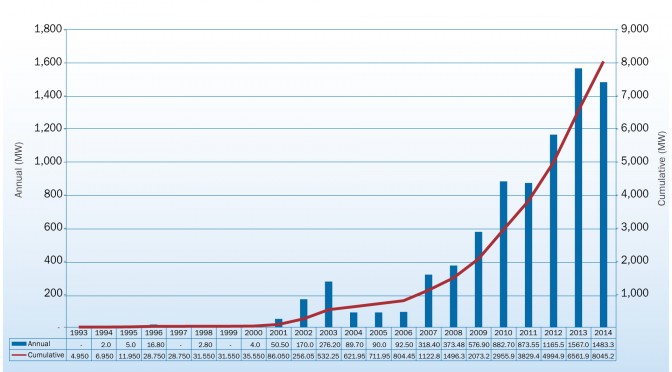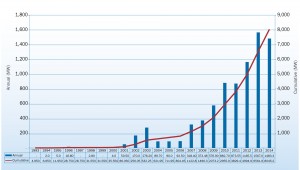In a milestone for the U.S. offshore wind industry, DONG Energy is entering the U.S. offshore market – the company explained why in a panel at the leading wind energy conference in North America, the WINDPOWER 2015 Conference & Exhibition.
Thomas Brostrøm, the Head of Markets & Pipeline at DONG Energy Wind Power, explained that the company is headquartered in Copenhagen, Denmark, and has a significant presence in the United Kingdom, Germany, Norway, Netherlands and France: “We’re a world leader in offshore wind, with our first project installed 25 years ago and still spinning. We’re aiming for 6.5 GW by 2020 and we’re almost there–we have one-third of all the offshore wind in the world.”
The firm decided to enter the U.S. market, Brostrøm said, because the physical conditions for offshore wind along the East Coast are promising (good wind speeds, water depths in which DONG Energy has experience), as well as because the U.S. Bureau of Ocean Energy Management (BOEM) has been working hard to encourage market development and several states have generating capacity needs that they hope to fill with clean energy.
The U.S. offshore wind industry has scored a major advance in recent weeks with the “groundbreaking” and beginning of component construction for Deepwater Wind’s Block Island Wind Farm.
Brostrøm was part of a panel on offshore wind that explored the opportunities and challenges for the industry. Other panelists in the session included Uffe Vinther-Schou of MHI Vestas Offshore Wind (a joint venture between Vestas and Japan’s Mitsubishi Heavy Industries); Mary Doswell, Dominion Resources; Paul Gallagher Sr., Fishermen’s Energy; and Doug Pfeister of the Renewables Consulting Group.
Climate change is a critical concern prompting Fishermen’s Energy’s interest in offshore wind, according to COO and General Counsel Paul Gallagher Sr. The commercial fishermen who founded the company “have seen firsthand that waters are rising, and that shellfish are being affected [by ocean acidification]. They’ve seen how clam boats used to leave the harbor and turn right [south], but now they turn left [north] because the clams are moving north.”
Fishermen’s Energy has been in a multi-year court battle with the New Jersey Board of Public Utilities (BPU), which denied its application for an offshore project. Gallagher said he is confident that the court will rule in ultimately rule in the company’s favor.
For his part, Uffe Vinther-Schou explained that MHI Vestas Offshore Wind is a new startup, formed a year ago, but has gone from 300 to 600 employees in that time. The company, he said, aspires to be a leader in offshore wind and has a multi-gigawatt pipeline for its 3- and 8-MW turbines.
Doug Pfeister explained that Renewable Consulting Group is a specialized expert services firm supporting the global renewable energy sector. The firm has been involved with offshore wind projects in Europe and hopes to see more action in the U.S. market. Of the Deepwater Wind 30-MW project off Block Island, he commented, “I think it’s what we need right now. There have been questions about offshore wind in the U.S., and the first demonstration project is going to answer lot of those questions.” The project, he added, should also create competition among the states, once they see that the technology is real and has potential economic benefits: “Given the good wind resource, good water depths, and access to ports that is available, Block Island should have a catalytic effect.”
Dominion Resources’ Mary Doswell noted that Dominion has been awarded $47 million by the federal government to install a pilot offshore wind farm off Virginia. She said that Dominion is trying to reduce costs for the project, but that on the plus side the company is a state-regulated utility, and therefore has no need for a power purchase agreement. It also has transmission capacity available close to the coast that is sufficient to handle not only the pilot project, but the estimated 2,000 MW of potential wind capacity off Virginia’s coast.



